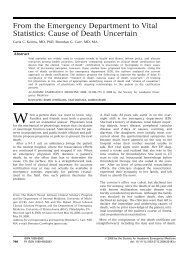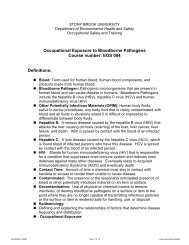Technological & Ethical Issues in Laboratory-Assisted Reproduction
Technological & Ethical Issues in Laboratory-Assisted Reproduction
Technological & Ethical Issues in Laboratory-Assisted Reproduction
Create successful ePaper yourself
Turn your PDF publications into a flip-book with our unique Google optimized e-Paper software.
7<br />
Initially, preimplantation embryos were transferred back to the uterus on the third day<br />
follow<strong>in</strong>g fertilization. More recently, embryos have been cultured <strong>in</strong> vitro for an additional 2<br />
days through development of the blastocyst. This approach has been taken to cull out those<br />
aneuploid embryos of poor quality that are dest<strong>in</strong>ed not to cont<strong>in</strong>ue to grow dur<strong>in</strong>g a longer<br />
period of culture. This allows the transfer of one or two high quality embryos to the uterus,<br />
achiev<strong>in</strong>g high rates of pregnancy while lower<strong>in</strong>g the risk of multiple pregnancy. There is<br />
evidence that approximately one third of embryos created by <strong>in</strong> vitro fertilization are aneuploid,<br />
and this <strong>in</strong>cidence rises with maternal age. It should be noted that there was <strong>in</strong>itial concern by<br />
basic scientists regard<strong>in</strong>g the safety of longer-term <strong>in</strong> vitro culture. The human embryonic<br />
genome is activated dur<strong>in</strong>g this time, and it was unclear whether there might be developmental<br />
problems <strong>in</strong> the offspr<strong>in</strong>g of these pregnancies, due to altered genomic impr<strong>in</strong>t<strong>in</strong>g, an epigenetic<br />
phenomenon <strong>in</strong> which a gene derived either from the mother or father is turned on or off. The<br />
details of this process are not well known and altered impr<strong>in</strong>t<strong>in</strong>g of genes could have the<br />
potential of caus<strong>in</strong>g harm. However, this does not appear to be the case, and the vast majority of<br />
children born from transfer of blastocysts appear to be healthy.<br />
Implantation rates have improved dramatically over the past 10 years. It is not unusual to<br />
achieve total pregnancy rates of 50-60% per treatment cycle <strong>in</strong> women under the age of 35.<br />
However, this <strong>in</strong>cludes biochemical pregnancies, <strong>in</strong> which a gestational sac is never imaged, as<br />
well as those cl<strong>in</strong>ical pregnancies that subsequently miscarry, occurr<strong>in</strong>g approximately 20 % if<br />
the time. Hence, the national live birth rate <strong>in</strong> the United States averages approximately 40 %
















